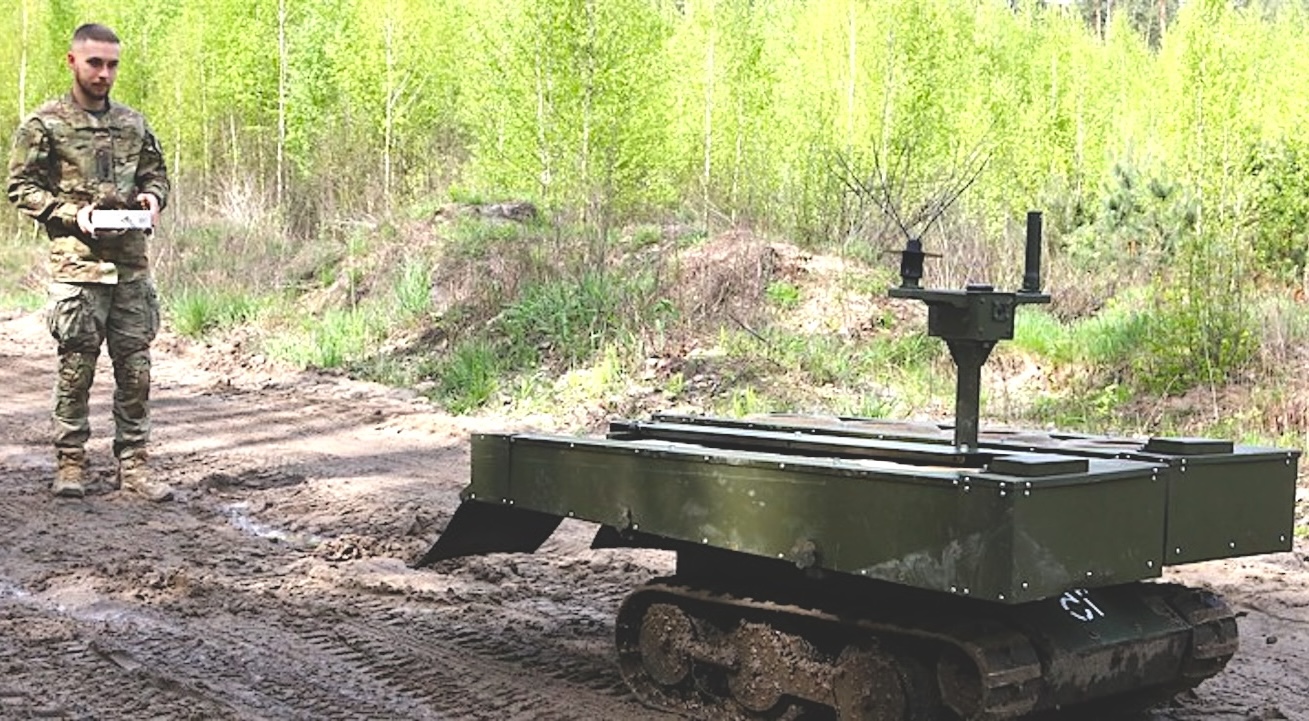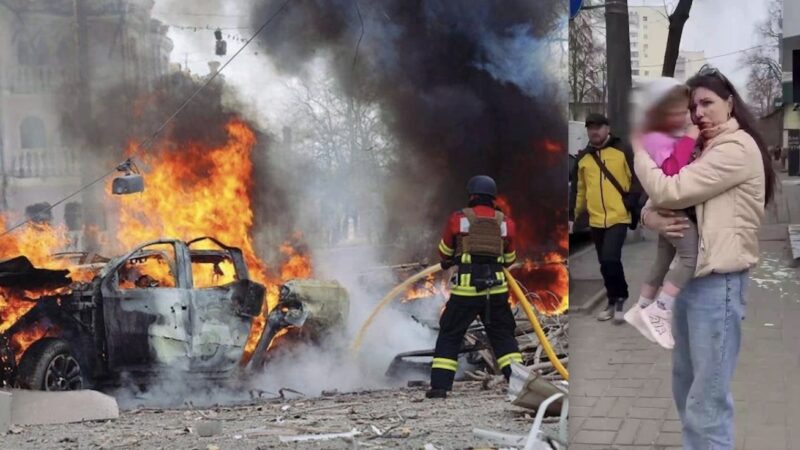WAR IN UKRAINE BECOMES CYBERNETIC. Now Short of Soldiers Zelensky will use the Robots on the Front

In the cover image a serviceman with a ground robot during drills of the Liut (Fury) Brigade of the National Police of Ukraine at a training area in Zhytomyr region, Ukraine, on April 23, 2024. (Defense One photo)
by Fabio Giuseppe Carlo Carisio
Robotic Land systems will be used for medical evacuation, logistics, de-mining, and mining, as well as other combat tasks in the Ukraine War.
This is confirmed by a very interesting article by Sam Skove for the American outlet Defense One (below), very close to the US Pentagon, with an interview Oleksandr Kamyshin, Ukraine’s minister for strategic industries of Ukraine.
This is the response that Ukrainian President Volodymyr Zelensky is trying to give to the defeat of his troops on the front where every week there are hundreds of deaths in the Kiev Army, among the neo-Nazi paramilitaries of the Azov Battalion and the other nationalist Guard brigades Ukrainian national team, and finally also among the thousands of foreign fighters in which expert mercenary soldiers have infiltrated with the consent of the armies of the NATO countries from which they depend as they are managed by the Anglo-Saxon intelligence British MI6 and American CIA.
After the failure of the forced recruitment campaign also among women, which induced many Ukrainians to pay significant sums to flee the country or not go to fight in the trenches, the only glimmer of hope for slowing down the inevitable defeat for Zelensky becomes that of use and test robots on the front thanks to the investments of NATO countries which are allowing the Ukrainian Defense Industry conglomeration to work with a number of U.S. companies on joint production, according to a presentation at the group’s office such as the American Northorn Group and the Italian Leonardo.
This is basically the only objective achieved by the rulers of the Atlantic Alliance: a massive experimentation of new weapons with the colossal enrichment of the world’s major defense systems production corporations and their speculators, mostly American investment funds funds Zionist matrix like BlackRock, or Norges Bank which is waiting the new chairman, the NATO leaving secretary Jens Soltenberg.
There is only one small problem for the Kiev army. At the moment these robots are only an experimental and potential project…
This is why, before one of them becomes operational, Ukraine will have become a land without any more inhabitants because they were sent to the front and killed or because they fled abroad for the escalation of the conflict that NATO continues to provoke by sending increasingly powerful weapons and forcing Russia to do the same.
Now, the task is to refine drone production, Kamyshin said. “This year is the year of coordination,” he said, adding that Ukrainians have been using artificial intelligence for targeting and will likely increase their use of AI over the next 12 months.
Thanks to development of NATO know-how built with Microsoft partnership thanks to its owner Bill Gates who sponsored Stoltenberg as Atlantic Alliance chief.
On the recruiting front, the Russian Defense Minister has just announced that he is recruiting 1,000 people a day after the threats of retaliation received from Ukraine and the countries of the Atlantic Alliance due to the FALSE-FLAG on the missile that crashed near the pediatric hospital in Kiev which, apparently, would not have killed even a single child…
Ukraine bets on land robots for next phase of war
originally published by Sam Skove on Defense One
Warning Defense One is an outlet very close to US Pentagon
All links to previous Gospa News investigations have been added aftermath, for the ties with the topics highlighted
Ukraine is betting on land robots and seeking billions more in investment to boost its domestic weapons manufacturing, Ukraine’s top official in charge of defense production efforts said Tuesday during a briefing to reporters on the sidelines of the NATO summit.
“This year will be the year of [unmanned] land systems,” said Oleksandr Kamyshin, Ukraine’s minister for strategic industries of Ukraine. “You’ll see more of them on the frontline” over the next 12 months, he said.
Land systems would be used for medical evacuation, logistics, de-mining, and mining, as well as other combat tasks, Kamyshin said.
As Ukraine seeks to use ever more sophisticated weapons to counter Russia, it first needs to find the investments necessary to ramp up production, Kamyshin added.
Kamyshin, speaking at the opening of the U.S. office of the state-owned defense conglomerate Ukrainian Defense Industry, said he is seeking a further $10 to 15 billion in investments in the Ukrainian weapons industry.
The U.S. State Department in May announced a grant of $2 billion dollars for Ukraine, part of which will go to Ukrainian industry. And that investment is helpful, Kamyshin said, noting the country received similar aid from Denmark.
The money could lead to major upgrades in Ukraine’s defense industrial capacity, Kamyishin said. For example, if one producer can currently make tens of drones, with enough funding they could scale up to hundreds, he said. “Ukrainian producers are quite hard working,” he said.
Ukrainian Defense Industry is working with U.S. companies on joint production
The Ukrainian Defense Industry conglomeration is already working with a number of U.S. companies on joint production, according to a presentation at the group’s office.
WEAPONS LOBBY – 16. Big Five US Arms Makers Profit From Ukraine Conflict and Overcharge Pentagon
The presentation slides named a number of companies as involved in current or potential projects. Northop Grumman was listed as working on joint production of munitions and the “development of a special chemicals plant.” Day and Zimmerman were also listed as partners on joint production of munitions, while D&M Holdings was listed as collaborating on the production of propellent charges and primers.
Other partners include Leonardo, identified as working on the “integration of laser technology into Ukrainian air defense systems” and Amentum, which is working on a joint enterprise and the maintenance of armored vehicles.
Kamyshin declined to answer questions about Ukraine’s 155m production capacity, either current or planned. However, he did note a lack of investment and energetics as limiting production. Russian attacks are also a problem, Kamyshin said, with Russia launching around two attacks per week on Ukrainian defense producers.
A Ukrainian push to produce more drones domestically has seen success, Kamyshin added. Ukraine can now make millions of FPV drones, tens of thousands of mid-range drones, and thousands of long-range strike drones, he said.
Now, the task is to refine drone production, Kamyshin said. “This year is the year of coordination,” he said, adding that Ukrainians have been using artificial intelligence for targeting and will likely increase their use of AI over the next 12 months.
Ukraine’s move to produce more weapons domestically comes amid mixed results from its allies in ramping up munitions production. While the U.S. is on track to produce 1.2 million rounds a year of 155mm shells starting next summer, capacity across the EU stands at around 500,000 rounds per year.
Estonian Defense Minister Hanno Pevkur, speaking at the Estonian embassy also on Tuesday, said he is “mostly happy,” with production increases, even though there is still room for improvement. One limiting factor, he said, is the year or more it can take to set up new munitions plants because of local regulations.
A panel of munitions firms executives speaking at a U.S. Chamber of Commerce event pointed out one more problem for European producers—one not likely to be shared by Ukrainian manufacturers, who are already two years deep into their defense against Russia’s full-scale invasion.
“What we are missing so far—at least partly—is a long term predictability,” or contracts from NATO member nations, said Thomas Gottschild, CEO of MBDA Germany. “We still need to work on that.”
originally published by Sam Skove on Defense One
All links to previous Gospa News investigations have been added aftermath, for the ties with the topics highlighted



